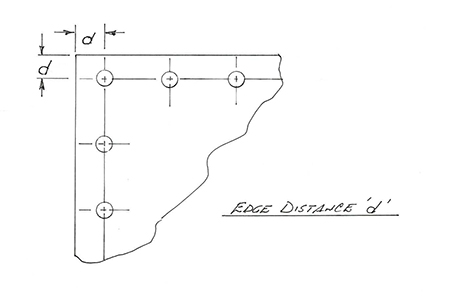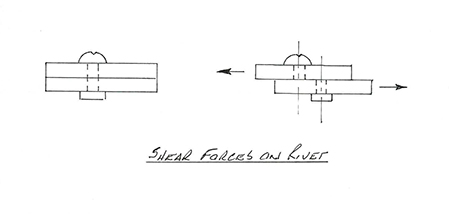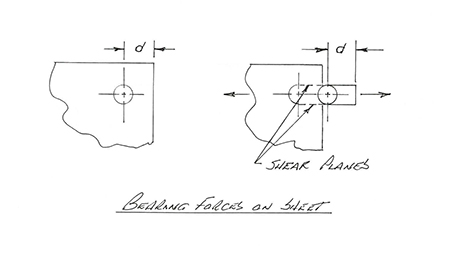Chapter 1410 High River Learn/Build Program Update — It’s All About Edge Distance
By Jack Dueck, Project Lead, EAA Lifetime 337912
December 2019 - I'm told the definition of an engineer is someone who gets excited about something absolutely no one else cares about. Perhaps that explains my obsession with edge distance. Edge distance is a term used in sheet metal aircraft construction. It refers to the distance from the center of a rivet to the edge of the material it is holding together.

Edge Distance
We know the common fastening system for aluminum aircraft components is rivets. Whereas wood construction uses glue and steel construction uses welding, aluminum aircraft use rivets.
In our workshops we tell students that the required edge distance for riveted joints using solid rivets is 2 to 4 diameters. I like to aim for 3. Then when looking through the literature provided in Zenith kits, we are told that an edge distance of 1.5 is required. Why the disconnect?
When two riveted parts are pulled apart, we have two forces at work. The first is the shearing force the aluminum sheet applies to the rivet, and the second is the bearing force the rivet applies to the sheet.
The following illustration shows the shear forces applied to the rivet. As you can see, the two sheets being pulled in the directions shown tends to shear the rivet.

Shear Forces
This illustration shows the same force applied by the rivet to the sheet tends to tear out the material of the sheet. The tearing of the sheet will occur along the two shear planes.

Bearing Forces
The shear force on the rivet is dependent on the alloy of the rivet and its diameter. The solid rivet we commonly use in building our airplanes is the AN470A rivet, composed of 2117 T4 aluminum alloy. Our texts tell us the shearing strength for a 1/8-inch-diameter rivet of 2117 T4 alloy is 331 pounds. Our texts also tell us that the same rivet exerts a bearing force of 360 pounds on a 2024 T3 sheet of aluminum of 0.032-inch thickness.
A riveted joint is considered most efficient when the shear force equals, or nearly equals, the bearing force. If the joint is critical in shear, it would suggest a larger or additional rivet. If the joint is critical in bearing, it would suggest a greater edge distance.
In the above example, the joint is critical in shear because the shearing strength that the rivet can withstand is less than the bearing strength that the sheet material can withstand.
So the shearing strength of this rivet is all about its diameter (or cross-sectional area), and the bearing force on this sheet material is all about its edge distance.
My trusty Aircraft Spruce & Specialty Co. catalog states that the shearing strength of the A-4 blind rivet used in the Zenith kits is 110 pounds. Since the maximum shear strength that this rivet can withstand must equal the bearing strength applied to the material by the rivet, we can deduce the following:
Forces equally applied to both the rivet and the material = 110 pounds
The area of the bearing planes = 2 x 0.032 x d = 0.64d
110/0.64d = 360/3 (where we use 3d as the preferred edge distance with the solid rivet)
d = 330/230.4 = 1.4
So 1.5d for edge distance with the Zenith A-4 rivet makes sense.
Just one of the many things we learn when building our own aircraft.
